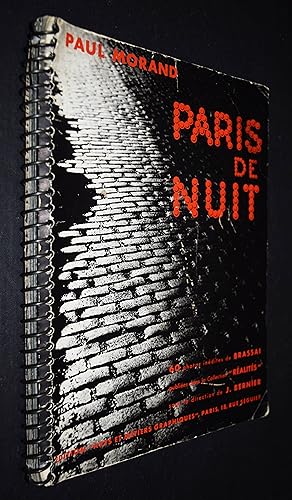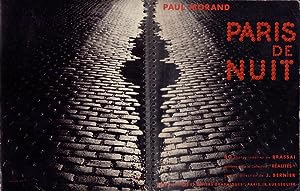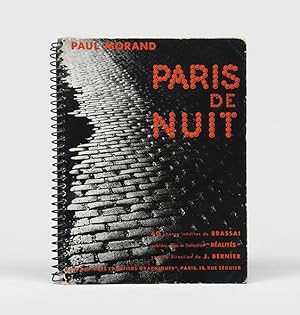paris de nuit von brassai: Bücher (8 Ergebnisse)
FeedbackSuchfilter
Produktart
- Alle Product Types
- Bücher (8)
- Magazine & Zeitschriften (Keine weiteren Ergebnisse entsprechen dieser Verfeinerung)
- Comics (Keine weiteren Ergebnisse entsprechen dieser Verfeinerung)
- Noten (Keine weiteren Ergebnisse entsprechen dieser Verfeinerung)
- Kunst, Grafik & Poster (Keine weiteren Ergebnisse entsprechen dieser Verfeinerung)
- Fotografien (Keine weiteren Ergebnisse entsprechen dieser Verfeinerung)
- Karten (Keine weiteren Ergebnisse entsprechen dieser Verfeinerung)
- Manuskripte & Papierantiquitäten (Keine weiteren Ergebnisse entsprechen dieser Verfeinerung)
Zustand
- Alle
- Neu (Keine weiteren Ergebnisse entsprechen dieser Verfeinerung)
- Antiquarisch (8)
Einband
Weitere Eigenschaften
Sprache (3)
Gratisversand
Land des Verkäufers
Verkäuferbewertung
-
Zustand: acceptable. Ausreichend/Acceptable: Exemplar mit vollständigem Text und sämtlichen Abbildungen oder Karten. Schmutztitel oder Vorsatz können fehlen. Einband bzw. Schutzumschlag weisen unter Umständen starke Gebrauchsspuren auf. / Describes a book or dust jacket that has the complete text pages (including those with maps or plates) but may lack endpapers, half-title, etc. (which must be noted). Binding, dust jacket (if any), etc may also be worn.
-
Hardcover. Zustand: Very Good. Zustand des Schutzumschlags: Very Good. Dust jacket in very good condition. Minor shelf and handling wear, overall a clean solid copy with minimal signs of use. Dust jacket placed in mylar for preservation. Text is in French. Minor loosening to binding. Secure packaging for safe delivery. 1.01.
-
Paris de Nuit
Verlag: Arts et Métiers Graphiques, Paris, 1933
Anbieter: Jeff Hirsch Books, ABAA, Wadsworth, IL, USA
Erstausgabe
First edition. Softcover. First printing. Text by Paul Morand in French. A collection of 62 full bleed photogravures that represent the height of printing and imagery of France at night. A likely unique copy that includes two examples of the front cover. A close to near fine copy in spiral binding with some of the usual minor rubbing and edge wear to the front and rear covers but with the second front cover much brighter and largely free of wear. Internally a clean copy. A very nice copy of one of the true high spots of 20th century photography books and on virtually every best of lists. (Parr & Badger v1, 134 , Roth 76).
-
Paris de nuit. 60 photos inédites de Brassaï (d. i. Gyula Halász).
Verlag: Paris, Edition "Arts et Métiers Graphiques" (C. Peignot) (1933)., 1933
Anbieter: Antiquariat Haufe & Lutz, Karlsruhe, BW, Deutschland
Erstausgabe
4°. [6] Bl. u. 62 Tafeln in Tiefdruck. Illustr. OKart. mit Metallring-Heftung. Auer 198. Bouqueret, Paris 116. Koetzle, Eyes on Paris 106 ff. The Open Book 110 f. Parr/Badger I, 134. Roth, The Book of 101 Books 76 f. - Erste und einzige Ausgabe des ersten und wichtigsten Werks des bedeutenden Fotografen. - "Un livre moderne, superbement imprimé, avec une relieure spiralée, qui va aussitôt s'imposer comme un ouvrage majeur au sein du monde de la photographie" (C. Bougueret). - "Instead of seeing Paris de nuit as a great 'might have been', therefore, one should think of it as ampngst the best produced and influential photobooks ever" (G. Badger). - "Erst Brassai hat unser Bild von Paris komplettiert. Er war es, der die andere Seite der Stadt, jene zweite spätere, finstere Tageszeit, die untrennbar zum 24-Stunden-Rythmus gehört, erkundet und aufgezeichnet hat. Zugegeben, bei Nacht, im Schatten der Gassen oder im Dunkel der Katakomben wurde schon vor Brassai fotografiert. Allerdings nie wirklich mit System, nach Maßgabe eines Konzepts und mit künstlerischem Anspruch. Brassai war der "Poète des nuits" und er war der Erste, dem ein mehr als überzeigendes Buch zum Thema gelang. . (Es) ist unter allen Titeln mit Paris-Bezug vermutlich der bekannteste, ein gedruckter Superlativ, der Brassai, den mehr oder minder mittellosen Immigranten, buchstäblich über Nacht berühmt gemacht hat" (H.-M. Koetzle). - Deckel mit wenigen Kratzspuren, Ecken mit Knickspuren, Vorderdeckel am Kapital und Fuß geringf. beschädgt (jeweils 2 Löcher an den Metallringen eingerissen), noch sehr gutes Exemplar. Sprache: französisch.
-
Paris de Nuit. Introduction by Paul Morand.
Verlag: Paris, Arts et Métiers Graphiques, 1933., 1933
Anbieter: Antiquariat CoBrA, Oberrohrbach, Österreich
Erstausgabe
Paris, Arts et Métiers Graphiques, 1933. Gr.-8°. 60 photohéliographic plates. Stiff photographic wrappers; ringbound; an unusual nice copy. Fine spiral binding ! First edition. - One of the classics of photographic literature, this extraordinarily evocative book is now very difficult to find in good condition. Brassai arrived in Paris in 1924 and prowled the city with his friends Henry Miller, Raymond Queneau, Jacques Prévert and Léon Paul Fargue. He used Kertèsz's camera. In 1933 his first book 'Paris de Nuit' was published. A book that remains one of the landmarks in the history of photography."Paris le jour/Paris la nuit", p.85 and passim. Original spiral bound photographic wraps printed in black and red. Spiral binding intact. Ownership inscription. Otherwise a very good plus copy of the notorious fragile book. Rare in this condition. Sprache: Französisch. *** Bitte kontaktieren Sie uns immer BEVOR Sie bestellen! Für ausführliche Beschreibungen und Bilder sowie günstigere Versandoptionen kontaktieren Sie mich bitte per Email! Please contact us always BEFORE you order! For detailled descriptions and photos as well as cheaper shipping options please send an email! ***.
-
Paris de nuit. 60 photos inédites de Brassaï.
Verlag: Paris, Arts et métiers graphiques, [], 1933
Sprache: Deutsch
Anbieter: Antiquariat Reinhold Pabel, Hamburg, Deutschland
Verbandsmitglied: BOEV
Erstausgabe
Paris, Arts et métiers graphiques, [1933]. [12] S. Mit 62 s/w Kupfer-Tiefdrucktaf., gedruckt bei Draeger. (= Collection "Réalités). 25 cm. OKart mit Spiralheftung. Erste Ausgabe (des ersten Fotobuchs Brassais). - Brassaï (d.i. Gyula Halász, 1899-1984), französischer Fotograf ungarischer Herkunft, kam nach Studien in Ungarn und Deutschland 1924 nach Paris. Sein Freund, der ungar. Fotograf André Kertész überredete ihn, die Faszination des Pariser Nachtlebens in Fotos einzufangen. 1933 erschien sein Bildband "Paris de Nuit", der ihn sofort berühmt machte: "Brassai, der Pariser aus Transsylvanien, erscheint als Engel der Dunkelheit. Seine Sensibilität genießt das Ursprüngliche, das Fantastische, das Zweideutige und sogar das Bizarre" (John Szarkowski, Museum of Modern Art, New York). - Deckelkanten gering berieben.
-
Paris de Nuit. 60 photos inédites de Brassaï, publiées dans la Collection "Réalités" sous la direction de J. Bernier.
Verlag: Paris: Édition Arts et Métiers Graphiques, 1933 [1932], 1933
Anbieter: Peter Harrington. ABA/ ILAB., London, Vereinigtes Königreich
Erstausgabe Signiert
First edition, first printing, of the photographer's first publication, double presentation copy, inscribed by Morand on the first page of text, "à Pierre Cot, Voici un joli décor pour La Patriouille etc. (Chut! chut! chut!) tres fideliement P. Morand Paris, fev. 32", and further inscribed by Brassaï across the following two pages, "Pour Christian-Vincent Matorasso, ce Paris de Nuit perdu et retrouvé avec toute ma sympathie, Brassai, Ete Village, le 7 mai 1965". The first recipient, Pierre Cot (1895-1977), was a politician central to the establishment of the French Air Force, and later of Air France. Morand's inscription alludes to La Patriouille, a display wing of the air force, the French equivalent of the British Red Arrows. Pasted below Morand's inscription is a small photograph of Brassaï in later life, which probably relates to the photographer's subsequent inscription. This is a superb copy of the work in which Brassaï showcases his mastery "at drawing luminosity from the darkness. The swaths of wet paving stones featured on the covers and endpapers of Paris de Nuit gleam like pale beacons in the streetlight. Inside, Brassaï explores the city, beginning with its broad vistas and grand public spaces and gradually moving into the demimonde he knew so intimately" (Roth, p. 76). It remains one of the most influential photobooks; signed copies are rare, and copies inscribed by both author and photographer rarer still. Parr & Badger I, p. 134; Roth, p. 76. Quarto. Illustrated with 62 full-page gravure plates, and 2 double-page plates as endpapers. Spiral bound monochrome photographic wrappers, front cover lettered in red. Housed in a custom black quarter morocco solander box by the Chelsea Bindery. A few punch holes slightly worn, covers lightly creased and rubbed at extremities, a few pages faintly soiled. A very good copy of a notoriously fragile book.
-
Paris de Nuit. 60 Photos inédites de Brassai.
Verlag: Paris, Arts et Métiers Graphiques, 1933
Sprache: Deutsch
Anbieter: Antiquariat Weinek, Salzburg, Österreich
Erstausgabe
Gr.-8°. 6 Bll. Text und 62 Photographien 25,5 x 20 cm. Illustr. OUmschlag mit Spiralheftung. Erste Ausgabe eines der berühmtesten Fotobücher des 20. Jahrhunderts über das nächtliche Paris. Nächtliche Aufnahmen ohne Kunstlicht galten bis dahin als unüblich. Tim Gidal widerlegte diese Ansicht durch seine Arbeit. 1923 zog er nach Paris, lernt die Künstlerkreise um Picasso und Dali kennen und beginnt 1928 mit den ersten Fotografien. Die Aufnahmen zeigen ein intimes, eher unbekanntes Paris, ein Milieu der Seitenstraßen, der Clochards und Prostituierten und kleinen Leuten. - Ein schönes Exemplar, die Spiralheftung hier in guter Kondition, ohne den meistens durch die Heftung verursachten Ausrisse. - Selten!









